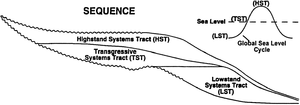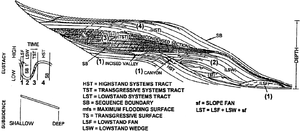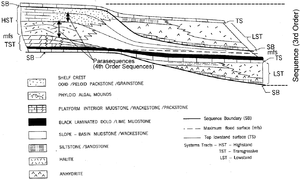Difference between revisions of "Third-order sequences"
FWhitehurst (talk | contribs) |
FWhitehurst (talk | contribs) |
||
| Line 62: | Line 62: | ||
# Lowstand | # Lowstand | ||
#* Rate of eustatic fall decreases, reaches stillstand, and rises slowly | #* Rate of eustatic fall decreases, reaches stillstand, and rises slowly | ||
| − | #* Lowstand wedge progrades seaward | + | #* Lowstand wedge [[Depocenter#Sediment_supply_rate_and_facies_patterns|progrades]] seaward |
# Maximum flooding | # Maximum flooding | ||
#* Most of shelf drowns as sedimentation outpaced by relative sea level rise | #* Most of shelf drowns as sedimentation outpaced by relative sea level rise | ||
Revision as of 21:12, 30 July 2014
| Exploring for Oil and Gas Traps | |

| |
| Series | Treatise in Petroleum Geology |
|---|---|
| Part | Predicting the occurrence of oil and gas traps |
| Chapter | Exploring for stratigraphic traps |
| Author | John C. Dolson, Mike S. Bahorich, Rick C. Tobin, Edward A. Beaumont, Louis J. Terlikoski, Michael L. Hendricks |
| Link | Web page |
| Store | AAPG Store |
During a third-order sea level change, cycle amplitude is great enough (approximately 50–150 ft) to expose the shelf. Depositional sites range from coastal plain to deep basin. The unit of strata deposited during a third-order cycle is called a depositional sequence. A depositional sequence has three subdivisions: highstand systems tract (HST), transgressive systems tract (TST), and lowstand systems tract (LST). Figure 1 shows a schematic cross section of a third-order sequence and its various systems tracts.
Third-order sequence deposition[edit]
The schematic cross section in Figure 2 is a third-order sequence model based on observations of the Tertiary of the Gulf of Mexico passive margin basin.[1] Although different basin types, i.e., foreland basins or active margin basins, require adjustments to the model, the Gulf of Mexico model still is useful for understanding third-order sequence deposition.
The order of deposition for the sequence shown in Figure 2 is as follows:[1]
- Sequence boundary formation and lowstand systems tract; fan deposition
- Rate of eustatic fall exceeds rate of subsidence.
- Sea level falls to shelf break, shelf is exposed, incised; canyon cut.
- Slope-perched deltas and submarine fans are deposited.
- Lowstand systems tract; wedge deposition
- Rate of eustatic fall decreases, reaches a stillstand, and rises slowly.
- Submarine fan deposition ceases.
- Incised valleys fill with coarse-grained, low-sinuosity channel or estuarine sandstones in response to sea level rise.
- Shale-prone wedge with thin, fine-grained turbidites forms on the slope, then downlaps the top of the submarine fan.
- Transgressive systems tract deposition
- Rate of rise is at a maximum.
- During brief slowdowns in the rate of rise, parasequences (fourth-order sequences) prograde; but overall they stack in a backstepping pattern.
- Organic-rich (condensed) section moves up onto the shelf.
- Fluvial systems typically shift from braided to meandering pattern.
- Highstand systems tract deposition
- Rate of sea level rise is at a minimum; in the late highstand, it falls slowly.
- Depositional rates exceed rate of sea level rise, causing parasequences to build basinward in aggradational to progradational parasequence sets.
- Parasequences downlap onto the condensed section.
Third-order sequence example[edit]
The Desmoinian of the Paradox basin, Utah, shown in Figure 3, is an example of a third-order depositional sequence.
Carbonate platform third-order sequence[edit]
The diagrams below outline the deposition of a sequence associated with a carbonate plat-form during a third-order sea level cycle. Sequence deposition begins with lowstand systems tract (2 and 3) and ends with the highstand systems tract (5).
- Highstand
- Rimmed shelf with accretionary slope apron pattern of progradation
- Forced regression
- Rate of eustatic fall exceeds rate of subsidence
- Sea level is at its lowest point and the greatest area of the platform is exposed.
- Platform eroded and sequence boundary develops
- Submarine fans and megabreccias deposited: begin- ning of lowstand systems tract deposition
- Lowstand
- Rate of eustatic fall decreases, reaches stillstand, and rises slowly
- Lowstand wedge progrades seaward
- Maximum flooding
- Most of shelf drowns as sedimentation outpaced by relative sea level rise
- Maximum flooding surface forms
- Condensed section develops across shelf, transgressive systems tract deposited
- Shelf margin is scalloped due to frequent collapse.
- Highstand
- Normal shelf sedimentation resumes as rate of relative sea level rise decreases
- Rates of deposition exceed rates of sea level rise: highstand systems tract progrades basinward.
- Facies on shelf reflect inherited topography form the lowstand (e.g., karst) and transgression (e.g., build-ups)
- Shallow shelf-sediments bypass slope to basin floor, which aggress
See also[edit]
- Sequence stratigraphy
- Basics of sequence stratigraphy
- Hierarchy of sequences
- Fourth- and fifth-order sequences (Parasequences)
- Traps in a framework of sequence stratigraphy
References[edit]
- ↑ 1.0 1.1 Van Wagoner, J., C., Mitchum, R., M., Campion, K., M., Rahmanian, V., D., 1990, Siliciclastic Sequence Stratigraphy in Well Logs, Cores and Outcrops: Concepts for High-Resolution Correlation of Time and Facies: AAPG Methods in Exploration Series No. 7, 55 p.


